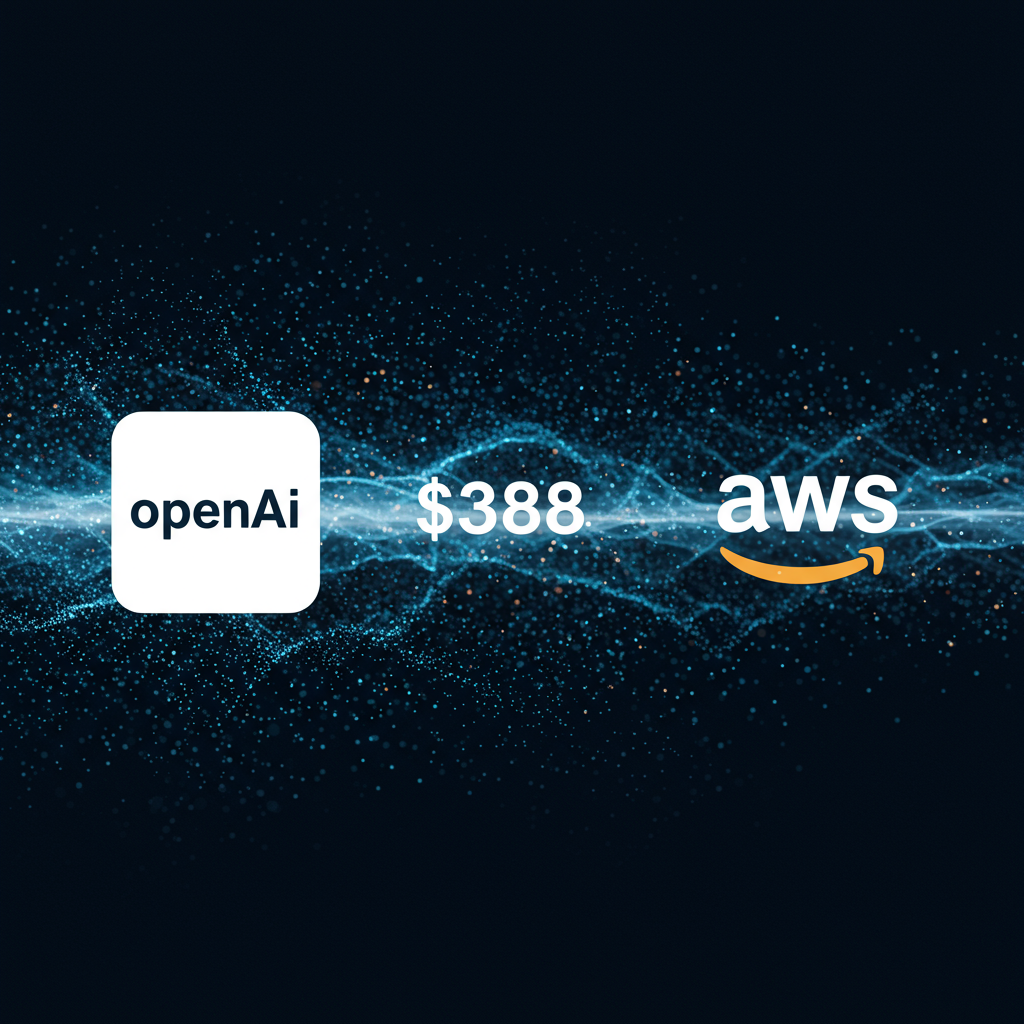The artificial intelligence landscape is in constant flux, marked by monumental investments and strategic partnerships. A landmark agreement has just reshaped the future of AI infrastructure: OpenAI, the pioneering force behind ChatGPT, has inked a staggering $38 billion cloud computing deal with Amazon Web Services (AWS). This seven-year pact is not merely a transaction; it’s a pivotal moment in the global AI race, empowering OpenAI with unparalleled computational muscle and solidifying AWS’s position at the heart of advanced AI development.
Unlocking Unprecedented Compute Power for AI Frontiers
OpenAI’s $38 billion agreement with AWS provides immediate and expansive access to Amazon’s cutting-edge cloud infrastructure. This includes hundreds of thousands of Nvidia graphics processors (GPUs) housed within AWS datacenters. These powerful chips, including advanced GB200 and GB300 AI accelerators, are the lifeblood of modern AI. They are absolutely critical for both intensively training OpenAI’s next-generation AI models and efficiently running existing applications like ChatGPT for its over 800 million weekly users.
The deal signifies a massive boost for OpenAI’s ambitions. Amazon plans to deploy these Nvidia chips in vast data clusters, directly powering ChatGPT’s responses and accelerating the development of OpenAI’s future AI breakthroughs. This planned capacity is expected to be fully operational by the end of 2026, with provisions already in place for further expansion into 2027 and beyond, showcasing the long-term vision behind this OpenAI Amazon cloud deal.
Sam Altman’s Vision: Scaling Frontier AI
OpenAI CEO Sam Altman has consistently emphasized the non-negotiable requirement for immense computing power to advance AI. “Scaling frontier AI requires massive, reliable compute,” Altman stated, underscoring the necessity of such colossal partnerships. He believes this collaboration with AWS strengthens the “broad compute ecosystem” essential for the next era of AI, ultimately aiming to bring advanced AI capabilities to everyone. Matt Garman, CEO of AWS, echoed this sentiment, affirming Amazon’s infrastructure would serve as a crucial backbone for OpenAI’s boundary-pushing ambitions.
A Strategic Diversification: Beyond Exclusive Reliance
Historically, OpenAI had a tightly knit, exclusive cloud agreement with Microsoft for several years. However, a significant restructuring at OpenAI earlier this year signaled a deliberate shift towards greater operational and financial autonomy. This included transitioning from its non-profit roots and adjusting its relationship with Microsoft, which now holds approximately a 27% stake in the newly formed for-profit entity.
This AWS partnership marks a clear strategic move by OpenAI to diversify its cloud service providers. The decision demonstrates a conviction that a multi-cloud approach is vital for long-term leadership in AI, preventing over-reliance on a single vendor. Kim Forrest, chief investment officer at Bokeh Capital Partners, observed that OpenAI’s “path to leadership is paved with getting access to as much computing power as it can get its hands on.” Beyond Amazon, OpenAI has already engaged with Google for cloud services and secured a $300 billion deal with Oracle for computing power, illustrating its aggressive pursuit of diverse infrastructure.
The Financial Magnitude of AI Infrastructure
The $38 billion AWS deal is just one piece of an astonishingly larger puzzle. OpenAI has publicly committed to an audacious $1.4 trillion spending spree on AI infrastructure. This colossal investment aims to develop 30 gigawatts of computing resources, an amount sufficient to power roughly 25 million US homes. These figures highlight the burgeoning demand for cloud-based AI compute power and the extraordinary capital required to remain at the forefront of AI innovation.
Addressing the “AI Bubble” and Sustainability Concerns
Such monumental investments, though signaling immense confidence in AI’s future, have naturally sparked debate among market watchers about financial sustainability. Reports from the Financial Times estimated OpenAI’s annual revenue at around $13 billion, a figure dwarfed by its $1.4 trillion infrastructure commitment. This disparity has led to concerns about a potential “AI bubble.”
However, Sam Altman has robustly pushed back against these financial anxieties. During a podcast appearance, he asserted that OpenAI’s revenue is “well more” than the reported $13 billion, though he did not specify an exact figure. He also expressed strong confidence in investor interest, noting, “I think there are a lot of people who would love to buy OpenAI shares.” Microsoft’s recent quarterly results, however, indicated OpenAI lost $12 billion in the last quarter alone, underscoring the intense capital expenditure involved.
Broader Economic and Environmental Implications
Analysts at US investment bank Morgan Stanley estimate global spending on datacenters could reach nearly $3 trillion by 2028. They project that major US tech companies will cover half of this, with the rest coming from sources like the private credit market. This growing “shadow banking sector” has, in turn, raised concerns among financial regulators, including the Bank of England and the International Monetary Fund, about broader market stability.
Beyond the financial landscape, the immense energy demand of AI data centers is a growing concern. The Lawrence Berkeley National Laboratory estimates that these facilities could consume up to 12% of US electricity by 2028. Public opinion also reflects these worries, with an AP/NORC poll revealing that 41% of Americans are “extremely concerned” about AI’s environmental impact.
Amazon’s Position in the Shifting AI Landscape
For Amazon, this $38 billion deal represents a significant vote of confidence in its cloud unit, AWS. Facing investor concerns about falling behind rivals like Microsoft and Google in the AI race, AWS reported strong growth in the September quarter, and the announcement sent Amazon’s stock surging by 4.7%, adding $140 billion to its market capitalization. This immediate positive impact underscores the market’s belief in AWS’s capabilities and its strategic importance in the AI ecosystem.
Experts clarify that this OpenAI Amazon cloud deal is primarily about the economics of computing power. Joshua McKenty, CEO of PolyguardAI, explained it as “strictly speaking about the economics of rent vs buy for GPU [graphics processing unit] capacity,” rather than altering data access permissions. Amazon already facilitates OpenAI models through Amazon Bedrock, an offering that provides various AI models for businesses utilizing AWS, further solidifying its AI strategy.
Frequently Asked Questions
What is the core purpose of OpenAI’s $38 billion deal with Amazon AWS?
The primary purpose of OpenAI’s $38 billion, seven-year deal with Amazon AWS is to secure massive, reliable computing power. This includes immediate and extensive access to AWS datacenters, specifically hundreds of thousands of advanced Nvidia graphics processors (GPUs). These GPUs are crucial for both intensively training OpenAI’s next-generation AI models and efficiently running existing applications like ChatGPT, enabling the company to scale its “frontier AI” ambitions.
How does this AWS partnership impact OpenAI’s broader AI infrastructure strategy?
This AWS partnership signifies a critical strategic shift for OpenAI towards diversifying its cloud computing resources. After years of exclusive reliance on Microsoft, OpenAI’s recent restructuring has allowed it to pursue a multi-cloud approach. This deal, alongside partnerships with Oracle and Google, reduces dependency on a single provider and is part of a larger $1.4 trillion commitment to build 30 gigawatts of computing resources, ensuring OpenAI can acquire as much compute power as possible to maintain its leadership in the AI race.
Are there financial risks or concerns associated with OpenAI’s massive AI infrastructure investments?
Yes, significant financial concerns have been raised. OpenAI’s $1.4 trillion infrastructure commitment vastly dwarfs its reported annual revenue of $13 billion, leading some market watchers to speculate about an “AI bubble.” While CEO Sam Altman dismisses these concerns, stating higher revenue figures and strong investor interest, the substantial capital expenditure required (evidenced by reported losses) and the reliance on growing private credit markets (which concern regulators like the Bank of England) highlight potential risks.
Conclusion: Shaping the Future of Artificial Intelligence
The OpenAI Amazon cloud deal is more than just a massive financial agreement; it’s a strategic alliance that will profoundly impact the trajectory of artificial intelligence. By securing unparalleled access to AWS’s infrastructure and Nvidia GPUs, OpenAI is fortifying its capacity to innovate, develop, and deploy increasingly sophisticated AI models. This partnership underscores the immense and growing demand for computing power that defines the current AI era. As companies like OpenAI continue to push the boundaries of what’s possible, these colossal infrastructure investments, while raising questions about financial and environmental sustainability, undeniably pave the way for the next generation of AI breakthroughs. The race for AI dominance is intensifying, and this deal marks a significant step in shaping that future.


